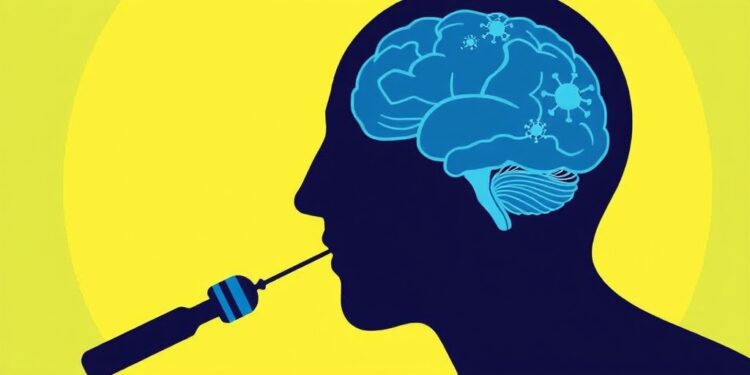Recent studies from researchers at the Massachusetts Institute of Technology (MIT) and Harvard Medical School illustrate the intricate relationship between the immune system and the brain, particularly highlighting the role of cytokines in influencing behavior during illness. Cytokines, which are immune signaling molecules, are known for their essential function in combating infections and orchestrating inflammatory responses. However, evidence is accumulating that points to their involvement in neurobiological processes, thereby impacting mood and behavior.
The cytokine interleukin-17 (IL-17) has garnered particular attention due to its unique duality in the context of brain functionality. Researchers discovered that IL-17 interacts with two disparate brain regions: the amygdala, which processes emotions like fear and anxiety, and the somatosensory cortex, responsible for social behavior. While IL-17’s action in the amygdala can lead to elevated anxiety levels, its effects in the somatosensory cortex seem to foster social engagement, suggesting that hierarchical cytokine actions are intricately woven into behavioral outputs.
The findings elucidate a fascinating interplay where the same immune molecule can precipitate polarizing effects on behavior based on its site of action within the brain. Lead researchers Gloria Choi and Jun Huh explicate how these interactions exemplify a burgeoning field of research where neural and immune responses are not merely coincidental but are deeply interrelated. This relationship is pivotal for understanding how humans and animals process illness beyond just physical symptoms, incorporating emotional and behavioral dimensions as well.
Choi and Huh’s previous work delved into the phenomenon termed the "fever effect," a temporary alleviation of behavioral symptoms in individuals with autism during fever. Their research posited that IL-17 participates in this phenomenon by modulating certain areas in the brain’s cortex. This led the researchers to further examine IL-17’s impact across varying brain structures and delineate its behavioral ramifications more precisely. Their endeavor unveiled the presence of IL-17 receptors, specifically IL-17RA and IL-17RB, within different neuronal populations in the cortex—including the S1DZ area, previously linked to autism-like behaviors.
This detailed receptor mapping is central to understanding how IL-17 governs neuronal excitability, primarily through the action of IL-17E, a variant of IL-17. IL-17E binding to its cortical receptors diminishes neuronal excitability, thereby yielding effects that can mitigate specific behavioral symptoms. This insight advances the hypothesis that IL-17 may have originally evolved as a neuromodulator, with subsequent roles emerging in immune modulation and inflammatory processes over evolutionary timescales.
As the researchers expanded their exploration further into the amygdala, they pinpointed another dimension of IL-17’s influence. The basolateral amygdala (BLA), reputed for its role in emotional processing, was found to harbor a distinct population of neurons responsive to IL-17A and IL-17C. These interactions yield heightened neuronal excitability, which predisposes animals to anxiety, thus imparting a clear link between immune activation and emotional dysregulation. This facet of their findings opens critical perspectives on how immune-related signaling could correlate with mental health issues.
Adding complexity to their findings, the studies revealed that artificially inhibiting IL-17 receptors could inadvertently lead to increased levels of circulating IL-17C. This unexpected result indicates a potential feedback mechanism that could complicate therapeutic strategies targeting IL-17 in clinical settings. Specifically, it raises caution regarding the mental health implications of medications designed to inhibit IL-17 activity, particularly in individuals predisposed to anxiety or mood disorders.
Choi speculates that this anxiogenic response may serve an evolutionary advantage during infections, compelling individuals to isolate themselves to curb the potential spread of pathogens. This behavioral tactic underscores the immune system’s broader role in regulating host behavior, demonstrating that it does not solely operate to combat infections but also to modulate host responses for community protection. Such perspectives could be critical for developing novel therapeutic strategies, enabling scientists to target immune pathways to effect changes in brain functions linked to mood and behavior.
These interconnected studies propose a framework in which immune signaling molecules, specifically cytokines, can yield diverse outcomes concerning brain function. As the research progresses, it becomes evident that context matters—how, where, and when these immune signals engage with neural circuits fundamentally matters to behavioral outcomes. The researchers acknowledge that there is still much mapping to accomplish regarding IL-17 receptors and their corresponding ligands across other regions of the brain.
Ultimately, understanding IL-17 and its receptor variations could illuminate new pathways for addressing neurological disorders, such as autism and depression, by considering immune system modulation as a viable therapeutic avenue. This reframing can inspire researchers to look beyond direct neural interventions, considering instead how systemic immune changes might influence cognitive and emotional health. Through such innovative paradigms, they hope to unveil new therapeutic avenues that intricately align immune function with neurobiology, offering hope for future interventions in mental health.
The interconnectedness between the immune and nervous systems, highlighted by these studies, has opened new avenues for research that may enhance our understanding of psychiatric disorders and their potential correlates with immune function. As these groundbreaking findings settle into the academic discourse, one could speculate on an exciting frontier in research establishment—where the immune system is not merely a defender against disease but a critical mediator of our mental landscapes, shaping who we are in times of health and illness.
The ramifications of this research could rewrite therapeutic strategies, enabling medical and scientific communities to address mental health holistically. Through further explorative studies, it could be plausible to induce beneficial changes in mood or behavior by subtly influencing immune responses, thereby creating a synergy between the immune system’s protective roles and neurological health. The ongoing dialogue within this field proposes an intricate narrative, bridging the gap between immunology and neurobiology, one that promises to deepen our comprehension of what it means to suffer and heal from the complex interplay of immune signals and human emotions.
Subject of Research: Interconnection between immune system and brain behavior via cytokines
Article Title: Inflammatory and anti-inflammatory cytokines bidirectionally modulate amygdala circuits regulating anxiety
News Publication Date: 7-Apr-2025
Web References: DOI link
References: None provided.
Image Credits: None provided.
Keywords: Cytokines, Immune system, Brain behavior, IL-17, Anxiety, Neuromodulation, Amygdala, Somatosensory cortex, Autism, Mental health, Neurobiology, Inflammation.




